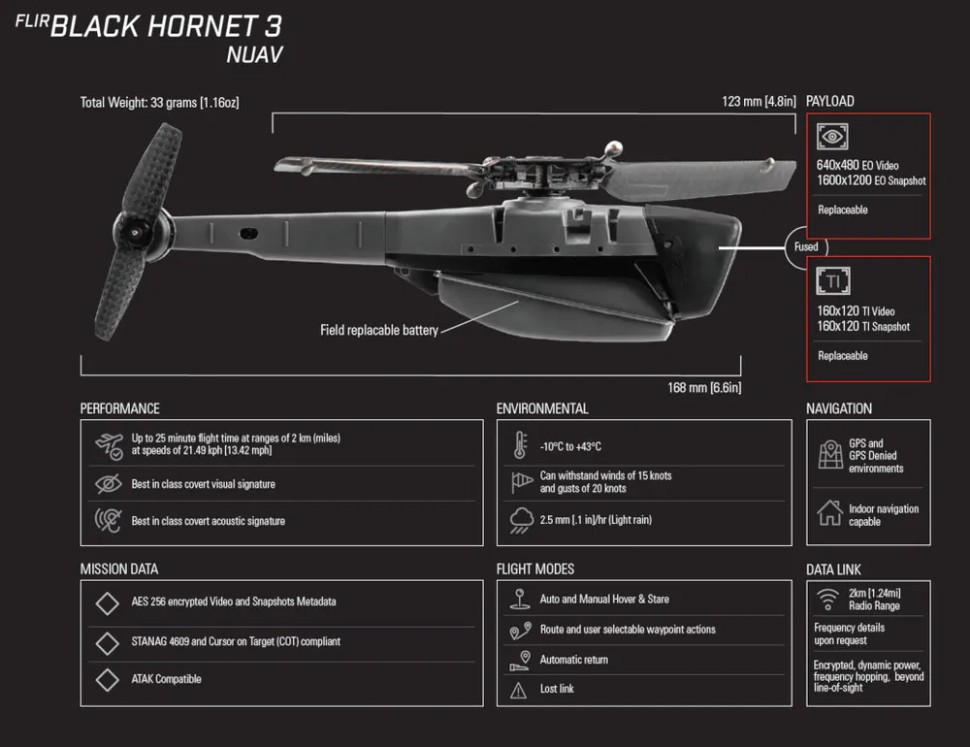
The $195,000 Black Hornet PRS military mini drone
 The Black Hornet Personal Reconnaissance System (PRS) is manufactured by FLIR Systems for use by military forces, government organizations and disaster relief agencies around the world.
The Black Hornet Personal Reconnaissance System (PRS) is manufactured by FLIR Systems for use by military forces, government organizations and disaster relief agencies around the world.
PRS uses the Black Hornet 3 unmanned aerial vehicle, which is an improved version of the battle-proven Black Hornet PD-100.
The unmanned aerial vehicle system is designed to assist dismounted soldiers deployed on the battlefield. It improves soldiers' situational awareness by acting as a dismounted covert soldier, delivering all key data about the environment and will spy on enemy movements to ensure the safety of frontline soldiers.
Black Hornet 3 design and specifications The PRS consists of two Black Hornet 3 UAVs and a ground control station. Black Hornet 3 features a compact and rugged design and offers a pocket-sized solution for covert operations. It is also touted as the world's smallest intelligence, surveillance and reconnaissance (ISR) UAV platform.
The PRS consists of two Black Hornet 3 UAVs and a ground control station. Black Hornet 3 features a compact and rugged design and offers a pocket-sized solution for covert operations. It is also touted as the world's smallest intelligence, surveillance and reconnaissance (ISR) UAV platform.
With a rotor diameter of 4.8 inches (123 mm) and a length of 6.6 inches (168 mm), the drone weighs no more than 33 g and offers a best-in-class audio and visual detection signature.
The range of applications that can be performed by the drone include immediate ISR and covert operations, situational awareness, beyond-line-of-sight (BLOS) reconnaissance and force protection.
Its compact dimensions allow the vehicle to be easily carried by soldiers along with their combat gear. The drone generates much less noise, making it suitable for stealth operations. It is capable of operating in wind speeds between 15kt and 20kt and temperatures between -10ºC and 43ºC.
The time required to launch a UAV varies between 30 and 120 seconds depending on the launch mode. The drone can be controlled in multiple flight modes, including auto and manual hover and hover, route and user waypoint actions, lost connection, and auto return.
Black Hornet 3 drone sensors and navigation system details
The Black Hornet 3 features two electro-optical (EO) cameras and night vision with a thermal LED light. It allows soldiers to capture live video and still images by extending their visual range.
The drone's navigational requirements are served by the Global Navigation Satellite System (GNSS). The drone can optionally be upgraded to visual-based navigation for indoor operation without GPS and built-in vector and raster maps. It also offers an encrypted data connection with a radio range of 2 km.

Black Hornet Personal Reconnaissance System Command Ground Station
The Black Hornet PRS is controlled by a Ground Control Station (GCS), which includes a base station, controller and display module. The base station can accommodate two Black Hornet 3 nano UAVs.
A one-handed controller can be integrated with the base station to execute and analyze mission plans. Mission data collected by the drone is transmitted to the base station for further analysis.
The control station integrates high-quality, lightweight displays offering daylight readability. The displays are powered by internal rechargeable batteries.
Power and performance
The Black Hornet mini drone is equipped with a replaceable battery that powers the main rotor and two-bladed tail rotor.
It can fly at a top speed of approximately 21.49 km/h and offers a flight endurance of up to 25 minutes and a range of 2 km.
Commercial video demonstration by FLIR
19 January, 2023 EN
EN  BG
BG